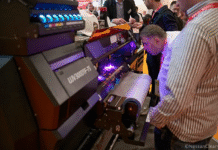Thinking forward to drupa 2021 the question arises: what role will commercial and publishing printing play in the future? They will, of course, play a role, but in a very different way than today. To a great extent the future of commercial and publishing printing lies in ‘individualization’ – the data driving this is online and forms the basis for print 4.0.
Profound changes in the media landscape had a significant impact on print for advertising and publishing. A large slice of the “advertising cake” is taken by online and social media channels, their worldwide share is estimated at 35% (source: Smithers Pira Calculation from World Press Trends Database). The economic indicators for commercial printing and publishing have long since been disconnected from the general economic situation. Economic upturns of recent years have not been mirrored and any growth of individual players has happened due to cutthroat competition.
Dramatic sales downturn
The consequences of this have been, on the one hand, a continuing consolidation process and, on the other hand, an associated workforce reduction. Between 2005 and 2015 sales revenues in Europe declined by 20% and the number of players fell by 14% to 110,000 firms (source: Intergraf). By 2020 total market revenues are expected to slightly exceed €70 billion and to level off thereafter.
This trend is also reflected in the demand for graphic papers. In Europe, in 2018, there was an 18% sales downturn in wood-free paper and by summarising this number for the last 10 years, we arrive at a percentage downturn in middle double-digits. Numbers from the USA do not show a better picture, where commercial print volumes have shrunk by almost 50% and returns by 80%, respectively. On the contrary, in this same time period, the US economy grew by over 70%. The only segment within the print industry to have profited during this time is the packaging.
Facing the transformation process
If you continue reading despite those sobering numbers, then you are courageous and indeed courage is what is needed to tackle the changes demanded by digital transformation and to prepare a company for the challenges that are still to come. In such a market environment, printing companies must reposition their offer and change their sales strategy. This involves focusing firmly on benefits for customers while understanding market requirements. “Whoever can clearly differentiate their business model, will be successful,“ assures Michael Fries, chief executive officer of Onlineprinters, during the 2019 Online Print Symposium in Munich.

Besides, customers themselves have also changed considerably. Decision-makers are more and more digitally [saavy] and it is key to be able to convey the benefits of print to young people – of which there are certainly enough. We need passionate employees in sales who appreciate the added value of print in a multimedia world and who can impress customers with print. “At the Adobe Summit in Las Vegas I had dozens of conversations with digital natives and they never questioned the importance of print. They want to print but rather on-demand, in real-time and fully personalized,“ concludes Horst Huber, Head of Werk-II.
Shaping change…
Obviously, the implementation of a new business or sales models can fail – but failing is better than doing nothing. To freeze up in shock from the fear of change does not get you anywhere. Whoever stands still has already lost. Hence the motto, “Whoever is not ready to tackle change will be overrun by it.” The print industry is still too focused on technology and is not thinking about business models. No question: technology is undoubtedly important, above all networked technology.
But it is still only a means to an end. There are enough successful business models and they have one thing in common: with the help of the internet and social media channels they enable individualized print products that offer more customer value. This is why online retailers are turning more to print. The German firm Adnymics has enjoyed resounding success by providing online retailers with personalized packaging inserts which add more emotional impact to the “moment of unpacking.” A further example is MyPostcard: Users of their app can easily upload pictures from their Instagram feed or their personal photo album, choose a layout, and finish their cards with a unique personalized message.
MyPostcard then prints and sends these individualized, unique items within 24 hours to anywhere in the world. Even the traditional catalog is enjoying a comeback – albeit in a strongly individualized form. This is, for example, the case with the German online retailer Bonprix who provides their customers with personalized mailings and folders based on their buying behavior. Their monthly print volumes are running at 13 million A3 pages and the trend is upwards. Personalization creates an added-value which in the case of Bonprix translates directly into strong sales growth. This added value itself can also justify the higher costs for personalized print.
Also, the trend in self-publishing is continuing, with photobooks as bestsellers and notebooks being among today’s most popular analog gadgets. A quote from Matthias Horx in Zukunftsreport 2019 is very pertinent: “If everything is always multipliable and available, then the unique, the specific, the tangible become the new luxury.” Technology trends Offset printing is technologically speaking largely exhausted. Today it’s all about process optimization and increasing efficiency. A glance at the Overall Equipment Effectiveness value shows why this is: The industry’s average lies at only 30%. Slumbering within today’s machinery is a significant potential for increased efficiency and for better margins.
How to make full use of this potential, whether with internal or external know-how, is a decision you have to make for yourself. What’s important is that this topic is focused and not ignored. Heidelberg follows this approach with its subscription model. It is also interesting to see how a paper producer like Sappi is devoting itself to the topic of increased efficiency. During the course of their process analysis, it came to light that up to 25% of all paper is thrown away. Their aim is to tackle this problem using OctoBoost, a cloud-based, modular platform, and working together with their customers.
The driver of transformation
Within the industry, digital printing is no longer considered as something marginal or dispensable. It is a key part of the ongoing digital transformation and underlies many new business models. Inkjet printing will confirm its potential by pushing even more into offset application territory. Much is made possible by the current developments in inks on one side and the broadening of the paper spectrum on the other. The stated goal is, sooner or later, to be able to print with inkjet on coated papers.
Edition 1 in an industrial environment
It is interesting to see how inkjet is pushing more into the area of sheetfed printing. Current sheetfed systems don’t have quite an appetite for print volumes, which sooner or later should help the process to breakthrough also in smaller markets. By combining with inline finishing solutions, sheet-fed systems bring a certain charm; typical print applications based on short runs can be very efficiently and flexibly produced. Canon has basically positioned its solution between toner-based digital print and offset, and assures that for runs of 300 to 1300 copies inkjet printing can score points economically.
It’s fascinating to see how fully complete first editions of books, brochures, and catalogs can be produced in an industrial digital print environment. Each product can look completely different in terms of content, size, or format. The production line is completely integrated and networked so that even despite the level of individualization, a required level of efficiency is reached. Thanks to today’s already achievable levels of automation, “mass customization” is no longer a future dream.
Take the offensive
Despite the huge changes going on, we now have tools at hand that for multimedia communications with print, can set the right accents. This means personalization and individualization captured on paper. To get there requires courage, tenacity, and a good dose of stamina. A visit to drupa 2021 can provide valuable inspiration. Don’t forget: today the business model decides over technology and not the other way around.
See you in Düsseldorf in 2021!
















